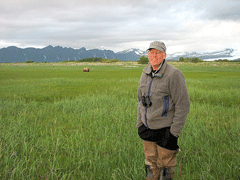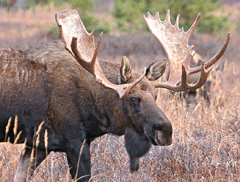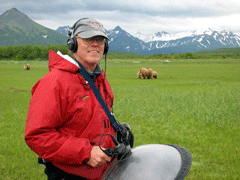Moose Milieu
Air Date: Week of October 13, 2006

Richard Nelson in Katmai National Park.
Alaska conservationist Richard Nelson takes us into Denali National Park in Alaska and tells us about the majestic moose.
Transcript
CURWOOD: It’s Living on Earth. I’m Steve Curwood.
Today we invite you to join us on an outdoor adventure. Richard Nelson is as much at home out in the wilds of Alaska as he is in front of his hearth. He is a cultural anthropologist, conservationist, hunter and writer, and a regular on the Alaska Public Radio Network and Raven Radio in Sitka. Now, in this first installment of an occasional series "Encounters," Richard Nelson takes us to Moose country.
[MUSIC PLAYING]
NELSON: It is a beautiful, quintessentially Alaskan day. I’m in Denali National Park.
[BREATHING SOUNDS]
I am hesitating because I literally just looked off to my left, I noticed a grizzly bear. Good-sized, broad-backed, heavy-bellied, pale, tan, working its way down a mountain ridge toward me. If it keeps coming this way I am going to have to move.
I am sitting here at a much closer range to an absolutely prodigious bull moose. This is one honker of an animal. A great, dark, chocolate brown bull moose with an immense rack of antlers—you may hear a little bit of breeze,
[SOUND OF WIND BLOWING THROUGH TREES]
warm breeze, it must be 70 degrees –sitting in a batch of very, very scrubby dwarf birch, and little willows and tundra vegetation.
In this area it’s about 2,000 feet elevation and it is well above timberline so I have a view of absolutely sprawling dimensions. Looking towards the east, along the road that runs into Denali National Park, up through the valley of the Tolklat River with great, rugged, rocky-ridged mountains, all the way around. And when I turn and look the other direction, towards the West, there is the immense snowy mass of Denali—the single most enormous landform in North America, climbing high up into a pale blue sky. I am surrounded by the quintessential icons of beauty and wildness in North America. And to add one more thing, about a quarter of a mile upstream from where I am sitting right now, there is a wolf den that has eight wolves in it, two adults wolves and six pups.
Moose once kept company with the great animals of the Ice Age: the mammoths, the saber tooth tigers, huge, long-vanished animals. Moose are a survivor of that era. Moose crossed the Bering Land Bridge from Asia about 150, 000 years ago. They are the largest member of the deer family; the same family that includes white-tailed deer, black-tailed deer, mule deer, elk, caribou. Alaska has the biggest moose in the world, prime Bull Moose weigh 1,200 to 1,700 pounds. They stand up to eight feet tall. This Bull Moose that is standing so close in front of me right now, has got to be near the upper end of that. Adult female moose are pretty substantial animals too, 800 to 1300 pounds. Their color is quite variable—as I mentioned the one in front of me is a dark, a chocolaty brown—but they can go all the way from reddish brown to almost black. Their legs are a grizzled, gray-color; very long, slender legs that are good for getting around in deep winter snow, also reaching high for their brows—as this moose is doing in front of me now, he is actually waded in like an animal that is wallowing in salad—taller than this moose’s head so it is reaching up, and as it does, I can see that huge rack of antlers swaying back and forth.
Grizzly bear moving fairly quickly now towards my left, coming down into the swale, walking in that swaggering gait, a heavy, heavy gait. I’m moving a little and that’s okay, I’ve got myself in a better spot. Our big moose has now turned and he’s looking straight at me with a benign curiosity. Great dark eyes shining in the sun, and now goes back to feeding, reaching up into that tall willow it is working on.

An Alaskan bull moose. (Courtesy of U.S. Fish and Wildlife Service)
Now, a look at the Alaska map shows you that this is really moose country. There’s a place called Moose Hill, there’s Moose Gulch, Moose Island, Moose Point, Moose Valley, Moose Village and Moose Pass. The dictionary of Alaska place names lists a total of seven Moose Lakes and forty-seven Moose Creeks. We need some originality I think in the naming of our creeks here!
Moose live in the great coniferous forest that sweeps all the way around the northern world, from Alaska, across all of Canada and down into some of the northern parts of the lower 48 states. Well, moose live almost everywhere in Alaska, from the mainland of the Southeast all the way up through the interior to the arctic slope. Their favorite habitat is around rivers, lakes and marshes throughout the interior and recently burned areas that are coming back with abundant willow and birch. Now this Bull Moose, near the edge of the Toklat River is well above timberline. So this moose is in a huge patch of willows and willows are very, very tall so that are well above the level of the moose’s back sometimes as he sort of swims along through this green ocean of willow. And at times all you can see is that rack of antlers moving back and forth as the moose sweeps around browsing on willow branches and willow leaves.
Moose are perhaps first and foremost an animal of winter. They seem almost impervious to the deepest winter cold. As you are traveling along by dog team or snow machine or perhaps along the road in the car, you will see them standing among the skeletal willows when it is sixty below zero, surrounded by a cloud of steam from their own breath. Their winter fur is very long and thick, and like the caribou, each hair on a moose’ s winter hide is hollow to give it excellent insulation.
The busiest time of year for moose is the fall rutting season. Bulls will rake their antlers on bushes, they strut and snort and grunt. Our bull here will eventually rake off the velvet from his antlers and he will thrash back and forth in the brush and bring those antlers to a high polish. He will then display those to other bulls and will stand broadside so another bull can see the mass of his body. They show off that way. Then they have shoving matches, pushing their antlers against each other to test their strength and establish who is dominant. They very rarely have serious battles but they often do get puncture wounds, occasionally even serious injuries, once in a while a moose will die from those battles of the mating season. Moose calves are then born about eight months later, mid-May to early-June. Cows in good moose habitat often have twins, rarely they will have triplets. That mother moose will fiercely defend her calves, never get between a cow moose and her calf. A calf moose will stay with its mother for about a year and then it gets driven away when the new calves are born— a rude separation from its mother.
Moose rarely live more than fifteen years, very few simply die of old age. Well, of course humans have been the most important predator on moose for countless thousands of years. Kenowun Indians, for example, who live in the interior of Alaska, have about fifteen words for different kinds of moose. Dineega is the general name for the animal and there are names like K'iyeedza, the biggest Bull Moose, or Deyozee, which means a cow moose. And Biditseega Hoolaanee, a cow moose with a calf or K'ik'onee Daadla, a yearling calf that that has left its mother—had that rude separation from mom. So we’ve got in front of us here K'iyeedza'—the largest bull moose.
Gwich'in people, who are neighbors just east of the Kenowun homeland are incredibly skillful moose hunters. They know all the best places to look for moose in every area and in every season. They know moose behavior so well they can predict exactly what an animal will do under almost every different kind of circumstance.
I remember being out with a Gwich'in hunter and he spotted two moose, the moose very quickly disappeared into a patch of willow. And they separated just as they disappeared. The man stopped and listened carefully, he didn’t move, and then all of a sudden he took off. I had no idea what was going on. What happened was he had heard the moose softly calling to each other. He ran towards that sound and very quickly got the one moose and then he stayed there and he kept imitating the call of the other moose. The other one came in and he got that one too. He knew that when moose separate they often circle back to find each other and call back and forth so they can locate each other, and he made use of that kind of knowledge.
Well, moose meat is the most important staple food in many interior Alaska villages and of course for many of us who live in Alaska. But also other parts of the animal are used: the hide for making warm, light weight clothing like boots. And then there’s a wonderful delicacy that you can find in many upper Alaskan communities called Moose Head Soup. You’ve got to know exactly which of the many muscles, lips, mouth tissues and bits fat to cut from the head to make this delicious delicacy.
Well by about 1900, populations of moose were severely depleted by over-hunting in most of North America. In fact, moose had become extinct in places like New England and the Great Lakes States. Then what happened is moose were protected completely from hunting, or there were strict hunting limits in areas where moose lived. Moose were also helped by re-growth of new forests after the cutting down of the old-growth forests or the burning of the forest. And then the legal protection of wetlands has also been very beneficial for moose because they like to frequent those marshy, swampy places. So moose populations—given these kinds of protections and these changes in habitat—have recovered very strongly over the past century. They are spreading back into areas where they had vanished, places like Maine, Vermont, Montana, Wyoming. They are even colonizing states where they have never been known to exist before, like Washington and Colorado. There are about one million moose in North America today. That’s as many as is estimated to exist when white settlers first arrived on this continent.
Oh my goodness! Just across the little river, about 150 yards away from me, is a black wolf moving quickly right along the edge of the willows. Probably that animal has been out all night hunting, just starting to head back home. It looks like it may have a big chunk of meat in its mouth—it’s heading back for the den.
So here now is our big bull moose, grizzly bear just up the draw, I can now see the grizzly just faintly at the edge of willows and then back behind, on the other side of the stream, the wolf. Where else in the world can you go to see all this?
Actually the moose has now come out of the willows—absolutely brilliant—against pale green vegetation, dark enormous moose, swaggering very, very casually and confidently right in the direction of that grizzly bear. I imagine that grizzly is going to have the sense to get out of the way of that moose. Oh my God, that moose is running straight towards me. It has gotten wind of the grizzly bear. Holy mackerel! Life is exciting. I’m just going to stand up here, right in the open, so that if the moose comes up on top of this ridge, it’s going to see that I’m a person and not a bear.
Where was I?
Hunters in Alaska take 6,000 to 8,000 moose each year. One adult moose can give you over 700 pounds of delicious, low fat, organic meat. You know how we tend to judge animals in Alaska not only by their beauty but by their nutritional qualities. Well moose have great economic value for Alaskans, not only as a source of food but also as a major attraction for hunters who come from all over the world. For wildlife watchers, for tourists who swarm up here from everywhere, coming from all around the world to see this wildlife, like the things that are in front of me.

Richard Nelson recording bears in Katmai National Park (Photo: Daniel Zatz.)
CURWOOD: Nature observer Richard Nelson comes to us courtesy of Raven Radio in Sitka, Alaska. His series "Encounters" is edited by Ken Fate. To find out more about Richard Nelson or the series, go to our website at www.loe.org.
Links
Living on Earth wants to hear from you!
Living on Earth
62 Calef Highway, Suite 212
Lee, NH 03861
Telephone: 617-287-4121
E-mail: comments@loe.org
Newsletter [Click here]
Donate to Living on Earth!
Living on Earth is an independent media program and relies entirely on contributions from listeners and institutions supporting public service. Please donate now to preserve an independent environmental voice.
NewsletterLiving on Earth offers a weekly delivery of the show's rundown to your mailbox. Sign up for our newsletter today!
 Sailors For The Sea: Be the change you want to sea.
Sailors For The Sea: Be the change you want to sea.
 The Grantham Foundation for the Protection of the Environment: Committed to protecting and improving the health of the global environment.
The Grantham Foundation for the Protection of the Environment: Committed to protecting and improving the health of the global environment.
 Contribute to Living on Earth and receive, as our gift to you, an archival print of one of Mark Seth Lender's extraordinary wildlife photographs. Follow the link to see Mark's current collection of photographs.
Contribute to Living on Earth and receive, as our gift to you, an archival print of one of Mark Seth Lender's extraordinary wildlife photographs. Follow the link to see Mark's current collection of photographs.
 Buy a signed copy of Mark Seth Lender's book Smeagull the Seagull & support Living on Earth
Buy a signed copy of Mark Seth Lender's book Smeagull the Seagull & support Living on Earth

